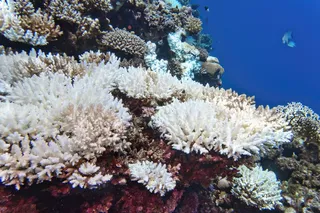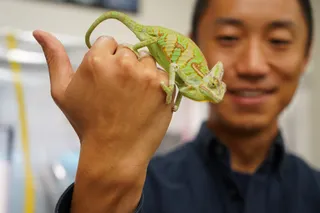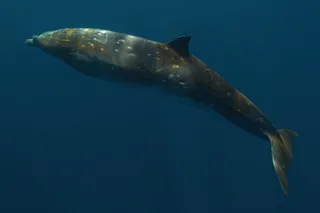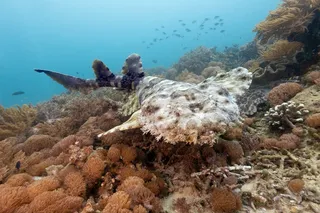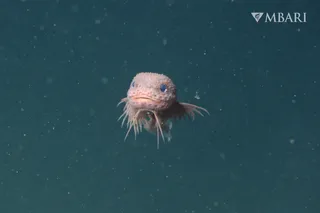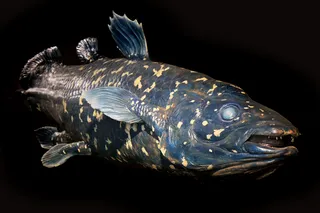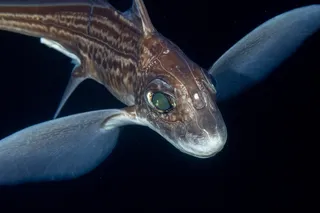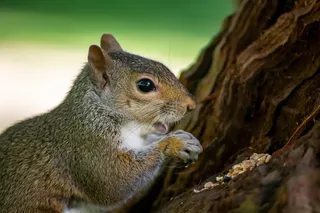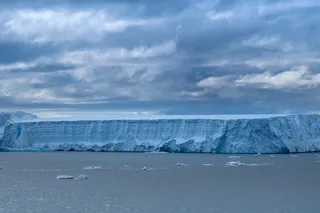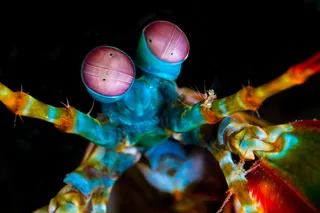Not long ago, one of the most bizarre creatures this world has ever seen showed up in North Carolina. Efforts to describe it have evoked the strangest comparisons: like grass feeding on sheep, said one scientist. And that’s not stretching things much. The creature is in fact a tiny plant with a Jekyll and Hyde personality, one that preys on animal life a million times its size. It has caused massive kills of fish and other marine animals around the world. Though hordes of the little monsters could easily fit on the head of a pin, keeping a culture of them active, say its discoverers, requires about 15 fish a day. It’s really not like a normal culture, they say. No joke.
The discovery of this deadly little squirt has caused quite a commotion among marine ecologists; though they have long known the monster’s relatives, no other members of the family have ever exhibited this upstart’s horrific predatory behavior. The fish killer extraordinaire is a measly dinoflagellate, a kind of alga, or single-celled aquatic plant. Dinoflagellates are twilight-zone creatures: half-plant, half-animal. They produce chlorophyll, but they also move about, using their two flagella, or whiplike tails, to swim rapidly through the water. Dinoflagellates, along with diatoms and a dozen other forms of microalgae, serve as the very bottom of the food chain and, at 450 million to a billion years old, are among the most primitive forms of life on this planet.
Dinoflagellates have long been regarded as the bad boys of the phytoplankton community, though perhaps a little unjustly--so far, only 42 of some 2,000 marine species are known to be toxic. The oldest mention of their nasty behavior occurs in the Old Testament: the first plague visited upon Egypt is a blood red tide that kills the fish and fouls the water. Red tides--which can actually also be green, yellow, or brown--are caused by algae blooms, excessive concentrations of dinoflagellates and other microalgae. The Red Sea itself may have been named for such a bloom.
More recently an increase of toxic blooms worldwide has alarmed marine ecologists. Not only do blooms appear to have proliferated during the last two decades, but species formerly thought harmless are now proving toxic. Their deadly appearances have led to immense revenue losses for the fishing industry and posed a threat to human health. A huge bloom in the Adriatic in 1989, for example, devastated the local tourist industry and the fishing community and caused $800 million in losses. An earlier toxic bloom, off the coast of Guatemala in 1987, caused one of the largest outbreaks of shellfish poisoning among humans in recent times. Although algal toxins can accumulate in shellfish without causing harm, when those shellfish are eaten by humans, serious illness and even death may occur. Almost 200 people fell ill during the Guatemalan outbreak; 26 died.
Researchers don’t know for sure what is causing the increase in blooms. Some believe they may be a manifestation of a long-term cyclical trend. Others think that what we’re seeing is the blooming of algal species that were always there in deep ocean waters but had never bloomed before. The new growth spurts, these researchers say, may be caused by natural factors, such as changes in currents or climate. Still others think the boom in blooms, especially in shallow waters and estuaries, is being triggered by an increase in nutrients via human sewage and agricultural runoff and that it signals the global deterioration of the marine environment. Whatever the cause, the discovery of the newest toxic dinoflagellate has done nothing but add a ghastly new twist to an old and increasingly perplexing problem.
The story properly begins one night early in 1988, with a massacre in Edward Noga’s laboratory at North Carolina State University in Raleigh. Noga is a fish pathologist at the university’s College of Veterinary Medicine. The scene was an aquarium filled with brackish water, and the victims were about 300 tilapias, African fish about two to three inches long; Noga was planning to use them for an immunology project. All the fish were okay on Friday, recalls Noga, and on Saturday they were all either dying or dead.
Noga and graduate student Stephen Smith immediately tried to trace the cause of the massive mortality. But they could find no pathogens on the skin or gills of the fish, and the cultures Smith took tested negative for bacteria. The only thing that seemed unusual to me, recalls Noga, was the presence in the water of an awful lot of dinoflagellates that seemed to have the same appearance. This suggested some kind of a bloom.
To test whether the dinoflagellates were responsible for the fish deaths, Noga and Smith set up five aquariums and stocked them with six fish apiece. Three of the tanks received a dose of a thousand dinoflagellates each; the two controls received none. Within 15 days blooms occurred in the three test tanks without discoloring the water, and 48 hours later all the fish in these tanks had died. It was a first: no dinoflagellate had ever been known to kill fish in an aquarium system before. The researchers then took water from a tank where fish were dying and filtered it, removing all bacteria, viruses, and dinoflagellates. When the water still proved lethal to 60 percent of the fish, they knew, says Smith, that the organism was producing something very toxic to fish.
Noga, wanting the killer identified, began sending out cultures. But the dinoflagellates were so small (just 10 to 20 microns, or less than 4 to 8 ten-thousandths of an inch, in diameter), so nondescript, and so difficult to culture by ordinary techniques that few scientists were interested in the little critters, and those who were couldn’t come up with an answer. JoAnn Burkholder, an aquatic botanist then new to the North Carolina State campus, was no exception.
When Noga first contacted Burkholder, she expressed little interest in the creature, citing no special knowledge of dinoflagellates. But he insisted, and she finally agreed to take a look. The critters, she told him, were just like three or four other nondescript little dinoflagellates common to North Carolina estuaries. She suggested that one of her part-time graduate students, Cecil Hobbs, might be interested in working on the ecology and life cycle of the mysterious dino. Hobbs, a former high school biology teacher, had a personal interest in--and perhaps something of a vendetta against--dinoflagellates. His family’s oyster beds in Sneads Ferry, North Carolina, had been wiped out by a red tide that hit the coast in 1987. The Hobbses’ oysters weren’t the only ones hit, of course. That bloom caused $25 million in losses to the local shellfish industry.
Making skillful use of a scanning electron microscope, Hobbs and Burkholder managed to get the first decent shots of the killer. Then they began to characterize the changes taking place in the dinoflagellate before, during, and after its kills. What they found had never been seen before. With no fish present, the creature simply sat in the sediment, encrusted in a hard, scaly, eggshell-like cyst. But when one or more fish began lingering overhead to feed, the creature shed its cyst, often within minutes. What emerged was a flagellated cell--the dinoflagellate stage by which this creature has become known. Quickly it filled the water with a lethal neurotoxin that paralyzed the fish, causing slow suffocation. In the face of impending death, the stunned fish leaned against the side of the aquarium, thrashing about as they struggled to get to the top. Then they dropped to the bottom, bumping their heads or falling on their tails.
Unlike most dinoflagellates, which move in a leisurely, winding sort of way, these made a beeline for their target--flecks of fish tissue stripped off by the toxin. They used a tonguelike absorption tube called a peduncle to attach themselves. As the frenzy increased, the dinos nearly doubled in size, the peduncle itself becoming swollen and assuming different shapes. In one picture, says Burkholder, it looks like a huge hand with tentacles and a clawlike thing at the end. We call it our Darth Vader shot. In the presence of this tiny terror, fish are not long for this world. Although the time frame varies, death can occur in as little as 20 minutes.
Burkholder and Hobbs think the attack is actually signaled by something excreted by the fish, though precisely what, they don’t yet know. The massacre ends, they think, as the amount of excreta in the water diminishes. The dinos then do one of two things. In less than a minute they can create and encase themselves in a new cyst and drop to the bottom to await more prey. This is apparently a protective measure; the cyst marks a dormant stage spurred by a lack of food or some other modification in their environment--a sudden change in water temperature, or turbulence from a storm. But alternatively, if there is no environmental stress and food (fish tissue) still remains, the dinos bizarrely enter instead a stage in which they transform themselves into amoebas. They shed their flagella, lose some of their toxicity, stop photosynthesizing, and become more animallike; once their rapid transformation is complete, they continue to feed on the fish bits at a more leisurely pace.
Burkholder has discovered that even after lying dormant for two years the dinoflagellate can still kill its prey, although it may then take about six weeks for the toxic cells to emerge from their cysts (whereupon, if no fish are present, they simply return to the cyst stage to await another passage of fish). While in the cyst stage, though, the dinos look absolutely harmless. Indeed, they fooled everyone--the fish, obviously, but also the scientists who had seen these cysts before but had never seen in them the face of a killer. Because these cysts so resembled those of a completely different kind of alga, a harmless chrysophyte, to anyone examining the water after a fish kill it looked as if no trace of a villain remained.
Hobbs and Burkholder had been working with the dinoflagellates for about a year when another wave of die-offs struck Noga’s aquariums, killing a thousand fish. I’m not sure how his tanks got contaminated, says Hobbs, but it was probably because we were all using the same refractometer (an instrument used to measure the water’s salinity). We thought we could contain this thing in one room, adds Noga, but we were very much mistaken. This is worse than any other infectious agent I’ve ever dealt with.
Hobbs and Burkholder went on to discover just how deadly their creature was. They found that the dinoflagellates could kill fish in anything from fresh water to full-strength seawater, though optimal growth occurred in water of midrange salinity. The researchers also learned that no fish was immune to the dinos’ toxin, although some, like striped bass, were more susceptible than others.
Burkholder and Noga now knew enough about the dino to search for it in the wild. But since the killer was too elusive to be caught by haphazard sampling, they enlisted help from North Carolina state biologists in hopes of nailing the phantom while a kill was in progress. They’d had a lot of sudden-death kills in the past decade or so with no explanations, recalls Burkholder. During 1988, the best-monitored year, they found 88 fish kills in the local Pamlico River between May and October. Their reports noted the fish sometimes exhibited neurotoxic symptoms and acted panicky. They told me that in some of the kills the fish were actually trying to get out of the water and onto the beach before they died; they called it a flounder, or crab, walk.
In May 1991 the phantom killer was finally caught with its peduncle on the goods. Kevin Miller, a state environmental technician, was sampling menhaden (a marine fish of the herring family) from an estuary off the Pamlico when a squall blew up. Forty minutes later, after seeking shelter in a protected bay, he returned to the sampling site to find the fish behaving abnormally. Then they started dying--by the millions. He took water samples and sent them off to Burkholder and Hobbs, who confirmed their toxicity and determined that the dinoflagellate responsible was the same one they’d had in culture for three years. And as expected, samples taken at the site the next day showed almost no dinos left in the water. Their retreat had been as rapid as their blitzkrieg attack.
Burkholder and Hobbs now definitely had their hands on the killer. But they had yet to tag it with an identity. The following October, however, they managed to take a photograph of it that revealed the faint outline of two cellulose structures sitting beneath surface membranes on the dinoflagellate cells. They suspected that these could be armored plates that serve as a protective covering for the cell when it is active. The presence or absence of such plates is one of the ways botanists classify a dinoflagellate species. Until this photo, the researchers had assumed the killer belonged among the naked species, which lack such armor.
At the end of the month, at an international toxic-phytoplankton conference in Rhode Island, Burkholder announced her findings: that this particular dino had plates, that the species went into a cyst stage, and that it hunted fish as prey. The audience, Burkholder recalls, was stunned. Most of the researchers there had assumed that phytoplankton toxins played a more passive role, as chemical deterrents to predators. But if Burkholder was right, this plant was a hunter armed with the equivalent of poison- tipped arrows. Burkholder’s findings started a scramble; though somewhat doubtful, researchers from the United States and 14 other countries with similar sudden-death fish kills returned home to hunt for the phantom alga in their local waters.
A few months later, in January 1992, the supervillain struck again--but this time its target was human. Howard Glasgow Jr., a research associate of Burkholder’s, was kneeling next to a drain on the floor of Noga’s lab, where the dinoflagellate experiments were being conducted. He was carefully rinsing out a ten-gallon aquarium that he planned to use for his upcoming project on the phantom dinos when he began to realize that he was not thinking properly.
Thoughts began rolling through his mind at a terrific pace; but when he reached to pull himself up, his hand seemed to take forever to move. Sensing trouble, Glasgow decided to leave the chamber, but his steps turned into something of a moon walk. I don’t know if it was really slow, or if I was thinking fast, he recalls, but something was drastically wrong. Glasgow recovered 15 minutes later and now remembers the experience as more euphoric than frightening. But the aerosol effects of toxin produced by dinoflagellates can be serious. For example, whenever the red tide produced by another dino, Gymnodinium breve, hits the coast of Florida, a dangerous aerosol is released for several days. During that period health warnings are posted telling people with heart and respiratory conditions to stay off the beach. The alga will come in on wave action, explains Burkholder, and when the cell fragments become airborne in sea spray, they can elicit sneezing, coughing, and severe asthmatic reactions.
Meanwhile the search for the killer’s identity went on. Burkholder, unsuccessful in her attempts to strip the outer membranes from the cells, turned for help to a colleague, Karen Steidinger, chief of research at the Marine Research Institute of Florida’s Department of Natural Resources and an expert in dinoflagellates. After several unsuccessful attempts on her own, in June 1992 Steidinger, using 100-proof alcohol, finally succeeded in stripping the stubborn membranes off the dino to reveal the armored plates beneath. With the plates’ existence finally confirmed, Steidinger and Burkholder were able to verify that their killer represented a new genus and a new species. They have proposed calling it Pfiesteria piscimorte (the genus name was picked to honor the late dino specialist Lois Pfiester of the University of Oklahoma and also because Burkholder liked the name’s echo of both feast and cafeteria; the species name means fish killer).
Over the next few months Burkholder and Glasgow continued to discover just how bizarre the new dinoflagellate really is. Its life cycle consists of more than 15 stages--it’s a veritable metamorphosing monster. The dino lives most of its life as an amoeba; in one toxic giant amoeboid stage it grows to be nearly 20 times the size of the flagellated toxic cells. The stage when the dino leaves its cyst to attack fish is actually quite ephemeral, appearing only when fish are present. The researchers also found that this stage is the only time the creature sexually reproduces; they again suspect that something in fish excreta triggers the reproductive urge.
Never before had marine dinoflagellates shown such stages. I’ve been working with marine dinoflagellates for 29 years now, Steidinger says, and I’ve never seen anything like it before. It has the most diverse life cycle I’ve ever seen. And this can’t be the only species out there. There have to be others.
Since the 1991 kill of menhaden off the Pamlico River, Burkholder and her students have confirmed the presence of the dinoflagellate in 11 other fish kills in North Carolina. Outside the state, the phantom killer has been found in Delaware in the Indian River. Anecdotal evidence suggests it was also responsible for a kill in Maryland in the Wye River, a tributary of the Chesapeake. They expect that many other kills previously labeled unknown may now be explained.
While researchers the world over are looking for the elusive dino in their own waters, others are trying to identify the toxin. Glasgow, for his part, is searching for the algal aphrodisiac--what it is in fish excreta that stimulates dinoflagellates to burst out of their cysts, feed on fish, and reproduce sexually. Burkholder is working on discovering the kind and concentration of organic and inorganic nutrients that stimulate the phantom dino’s growth. She’s already found that waters with excessive amounts of phosphorus and nitrogen seem to favor the organism. Last but not least, she hopes to find natural predators as a way to eventually control the dinoflagellate. One candidate, a microscopic animal called a rotifer that is a natural predator in estuaries, looks promising. In dino-infested waters, Burkholder has seen the guts of rotifers packed with dinoflagellates.
But finding an able opponent for the dino may not be easy. Burkholder laughs nervously as she recalls the day an undergraduate came running into her office with the news that all the dinoflagellates in a fish tank were dying. When Burkholder looked under the microscope she was surprised to find a protozoan, which had somehow gotten into the tank, busily consuming both the dinos and their cysts as the dinos themselves were attacking and killing the fish. But once the fish had died, the remaining dinoflagellates started to circle the protozoan. Then, like something from a grade B science fiction movie, a few of those dinoflagellates formed into giant toxic amoebas, which--you guessed it-- completely engulfed the protozoan.



